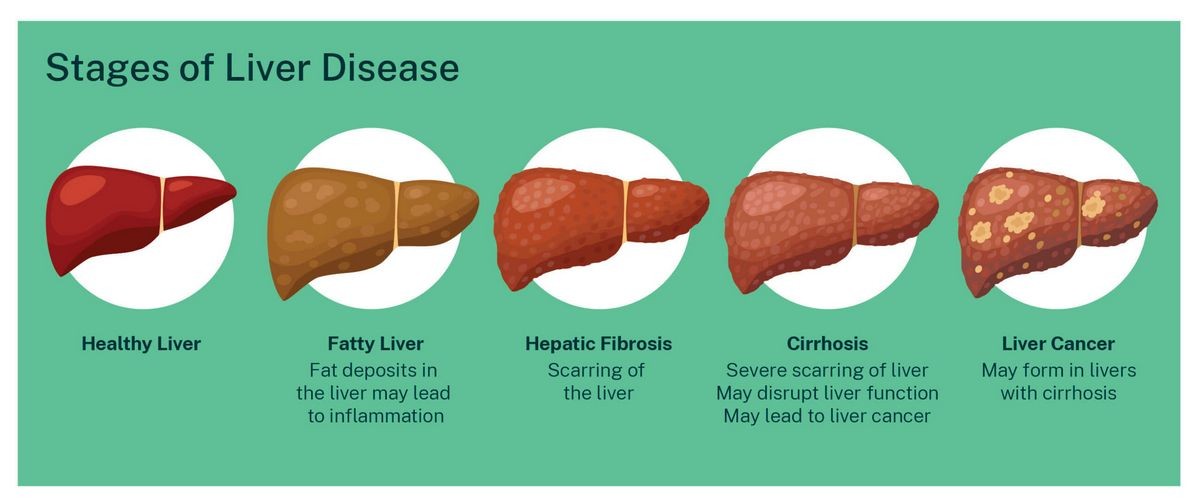
Contents
- 1 What Are the 4 Stages of Cirrhosis of the Liver?
- 1.0.1 Compensated vs. decompensated cirrhosis
- 1.0.2 What are the signs of liver failure?
- 1.0.3 What is the difference between acute and chronic liver failure?
- 1.0.4 How will I know if I have liver cirrhosis?
- 1.0.5 What causes cirrhosis of the liver?
- 1.0.6 What are the treatment options for liver cirrhosis?
- 1.0.7 From
What Are the 4 Stages of Cirrhosis of the Liver?
Cirrhosis of the liver is a disorder in which healthy liver cells are gradually replaced by scar tissue. It is a progressive illness that might take several years to develop.
Cirrhosis is classified into four stages:
- Stage I: Steatosis
- Inflammation of the bile duct or liver is the first stage of liver disease.
- Abdominal discomfort is frequently the first symptom of inflammation as the body fights against the disease or infection.
- If this inflammation is not managed, it might cause further damage to the liver.
- Symptoms and inflammation are generally treatable during stage I and can prevent liver disease from escalating.
- Stage II: Scarring (fibrosis) of the liver due to inflammation
- Many people with liver illness don’t realize they have it until they are at stage II or III as the first symptoms generally go unreported.
- In stage II, scarring or inflammation begins to obstruct the natural flow of blood in the liver.
- This causes the liver to be unable to function properly, but treatment can still help to slow the progression of the disease.
- Stage III: Cirrhosis
- Cirrhosis develops due to the advancement of liver disease, mainly due to lack of therapy.
- Scar tissue replaces healthy liver cells, causing permanent scarring.
- The liver will eventually be unable to function properly as scar tissue blocks blood flow.
- This can lead to additional problems if blood is prevented from flowing into the liver.
- Stage IV: Liver failure or advanced liver disease or hepatic failure
- Liver failure during the final stage of the disease signifies the end of the liver’s functioning.
- Quick medical intervention is necessary to avoid fatalities.
Compensated vs. decompensated cirrhosis
Compensated cirrhosis
- This phase is asymptomatic because healthy liver cells can meet the body’s needs and compensate for scarred tissue.
- Treatment is necessary to prevent the illness from escalating to liver failure and to rid the body of toxins efficiently.
Decompensated cirrhosis
This type of cirrhosis causes various symptoms and can lead to various problems, including:
- Bleeding of varices: Varices are dilated blood vessels in the stomach or esophagus caused by obstruction of the portal vein to the liver.
- Hepatic encephalopathy: A loss of brain function due to the liver’s inability to eliminate poisons from the blood.
- Ascites: The accumulation of fluid in the peritoneum (abdominal cavity).
- Jaundice: Yellowing of the eyes and skin due to a high amount of yellow pigment bilirubin in the body.
- Gallstones: An increase in the bilirubin chemical can contribute to the production of gallstones.
QUESTION
What are the signs of liver failure?
The signs of liver failure include:
- Altered consciousness
- Bleeding through the rectum or vomiting blood
- Severe abdominal distension
- Diarrhea
- Vomiting
- Fatigue
- Jaundice
- Weakness
- Itching
- Loss of appetite
- Bruising easily
Cirrhosis can lead to liver failure over several years. Early diagnosis and treatment enhance prognosis and prevent liver failure.
What is the difference between acute and chronic liver failure?
Acute liver failure is sudden onset, whereas chronic liver failure is gradual onset.
Other differences may include:
- Acute (sudden) liver failure:
- This type of uncommon liver failure proceeds quickly and occurs within a few days or weeks.
- It usually affects people who do not already have liver disease.
- The illness frequently manifests itself suddenly, with no signs or warning.
- The most common causes are drug overdoses, poisoning, or severe hepatitis A infection.
How will I know if I have liver cirrhosis?
Symptoms of cirrhosis vary depending on the stage of the disease. Some people may experience no symptoms in the early stages. Symptoms may not develop until the liver has been severely damaged.
The twelve symptoms of cirrhosis include:
- Fatigue or weakness
- Nausea and vomiting
- Loss of appetite
- Unintentional weight loss
- Abdominal pain or tenderness
- Increased bruising and bleeding
- Jaundice
- Severe skin itching
- Peripheral edema
- Fluid buildup in the abdomen
- Hepatic encephalopathy
- Darkening of urine color
If you experience any of these symptoms or are concerned about liver cirrhosis, see a doctor as soon as possible.
If you have any of the following symptoms, go to a hospital or visit a doctor right away:
- Blood-tinged sputum or blood in vomit
- Symptoms of fever or chills
- Red or hot swelling
- Difficulty breathing
- Fainting-like episodes
- Black or tar-colored stools
What causes cirrhosis of the liver?
The majority of cases of liver cirrhosis are caused by excessive alcohol consumption or chronic viral hepatitis.
Other causes include type II diabetes, obesity, and nonalcoholic fatty liver disease.
Rare causes include autoimmune chronic active hepatitis, drugs and chemicals, and inherited metabolic disorders.
By clicking Submit, I agree to the MedicineNet’s Terms & Conditions & Privacy Policy and understand that I may opt out of MedicineNet’s subscriptions at any time.
What are the treatment options for liver cirrhosis?
Treatment focuses on curing the underlying cause of cirrhosis to prevent further damage.
A doctor may prescribe antiviral medicines for viral hepatitis infections and steroid medicines if the cause is an autoimmune disease.
Lifestyle and diet changes can also help control symptoms and lower the risk of problems:
- Drinking less alcohol (or not at all)
- Losing weight
- Smoking cessation
- Regular exercise
- Healthy, balanced diet
- Reducing salt intake
- Practicing good hygiene
- Getting vaccinations
If the liver is severely damaged, a liver transplant may be offered as a last resort.
Cirrhosis caused by alcohol abuse or obesity can be avoided by making changes in the early stages of the disease. However, genetic ailments or immune system issues may be more difficult to prevent.
Once the liver is severely damaged, there is no way to repair it.
From
Healthy Resources
Featured Centers
- What Are the Best PsA Treatments for You?
- Understanding Biologics
- 10 Things People With Depression Wish You Knew


